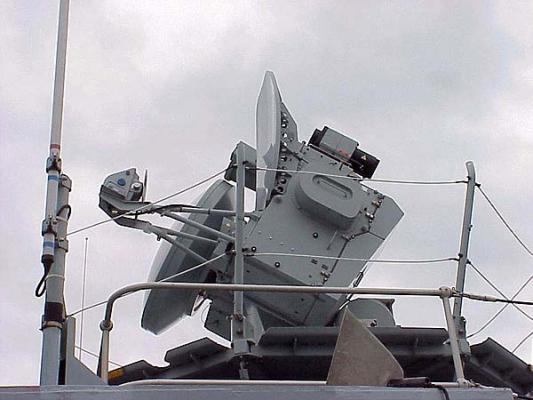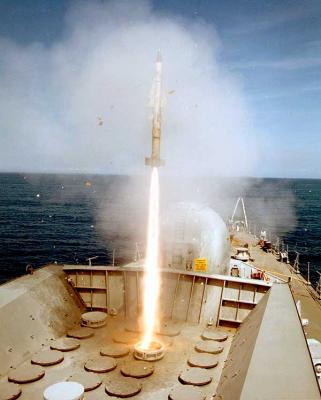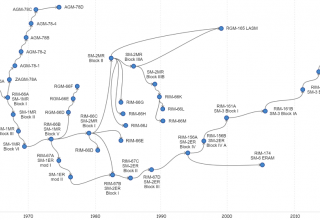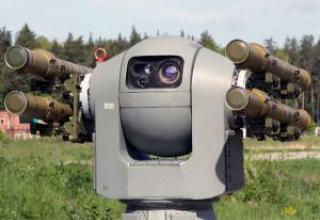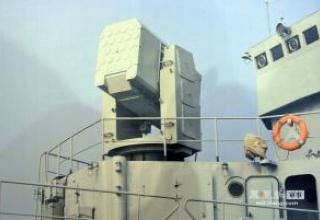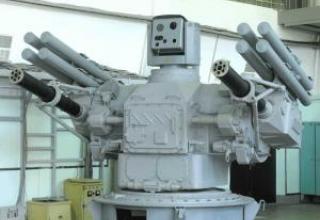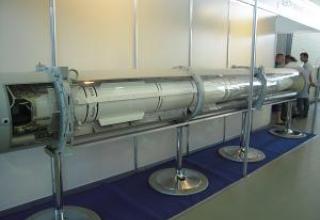Sea wolf" short-range anti-aircraft missile system is intended for firing at group subsonic and supersonic low-flying targets.
It is a part of the GWS25 all-weather SAM system of several modifications, of which the basic GWS25 ModO is in service with the frigates of the URA type 22 ("Broadsworth") since 1973.
In 1991, it underwent a major upgrade and was adopted by the British Navy as the GWS26, which is designed to be fitted with Type 23 Duke frigates.
It was developed by British Aerospace Defence.
Composition:
The basic version of the SAM system for arming ships of up to 3000 t displacement includes:
- Pulse Doppler radar 967 for detection of air targets (frequency range 1-2 GHz),
- Surface target detection radar 968 (frequency range 2-3 GHz),
- Radar 910 for target tracking (frequency range 8-20 GHz),
- a television tracking system for the missile and the target,
- central computer FM-1600V,
- the control command transmitter,
- two six-charged PU and a fire control system,
- the operator desks,
- rockets,
- a rocket store.
Sea wolf" missiles (see photo ) of the basic version have radio command guidance on the sighting line. The 967 radar detects air targets with an EPR of about 10 m 2 at a range of 70 km and determines their main parameters (speed, course, dimensions). The calculator determines the priority of hitting the ship with a group target, selects the fore or aft PU for firing and introduces the optimal value of the aiming angle. When shooting at a single target can be launched a single rocket "Sea wolf", on a maneuvering aircraft more effective volley launch of two missiles.
Navigation of the SAM is carried out by means of a radio command system with separate sighting of the target and escorting the missile. The 910 radar accompanies the target, and the location of the SAM is determined by the signals of an airborne radar transponder operating in the same range. Two of the four antennas at the ends of cruciform wing consoles transmit signals to the radar, the other two receive control commands. The difference between the missile's trajectory and the beam centerline is measured 100 times per second. The deflection parameters are transmitted aboard the LSD. Since the relatively wide beam of the tracking station is ineffective at elevation angles below 1.5°, a television system is used to track low-flying targets.
The system is capable of hitting targets flying at a speed of about 2M at high and low altitudes in the zone up to 6 km. The distinctive feature of the complex is low reaction time (5-6s) and full autonomy of action from the moment of target detection to its interception. Pulse Doppler radar of the complex captures the target with EPR up to 0.2m2 within a radius of 10km and with EPR less than 0.2m2 - at a distance of 5-6km from the ship.
A modification of GWS25 Mod3 SAM system has been developed for arming ships of less than 1000 t displacement and firing at anti-ship cruise missiles with mixed trajectory. The complex uses twin or quadruple PU. The radar911 (frequency range 8-9 GHz) and radar VM40 provide target tracking.
The GWS26 mod.1 modification has a vertical launch vehicle and an upgraded missile. The GWS26 mod.1 launcher includes a package of 32 transport and launch containers. The English frigates of the Norfolk type (the lead ship was put into the Navy combat service in spring 1990) are equipped with one GWS-26 mod.1 UVP by 32 Sea wolf anti-aircraft missiles in the bow of the ship. Its full displacement is 4200 tons, maximum speed is 28 knots.
Sea wolf" vertical launch surface-to-air missiles are additionally equipped with a launch accelerator with a thrust vector control system, which ensures fast turnaround to the target after launch. Due to the launch accelerator, the missile length is increased to 3.0m and the launch weight to 140 kg. After turning, the accelerator is reset. In UVP, anti-aircraft missiles are located in the TIC (eight in each of the four modules). Preparation for launch and launch of all missiles of one module is carried out with the help of the launch control unit. The total mass of the module with the missiles and control units is 3.4 tons.
Characteristics:
| Range, km | 6 |
| Intercept altitude range, km | 0.01-5 |
| Probability of hitting the target with one SSD (volley) | 0.85 |
| The length of the rocket, m | |
| GWS25 | 1.8 |
| GWS26 | 3 |
| The diameter of the rocket body, mm | 180 |
| Wingspan, mm | 450 |
| Start weight , kg | |
| GWS25 | 82 |
| GWS26 | 140 |
| Weight of shrapnel-flagged combat unit, kg | 14 |
Testing:
In the Anglo-Argentine conflict, five Argentine aircraft were shot down using this complex. Attacks by British frigates like "Broadsworth" links of four attack aircraft like "Skyhawk" each link lost half of the planes, the rest, trying to hit the ships with antimissile maneuver, bombed inaccurately. As a result, even before the end of the conflict, Argentine pilots began to avoid encountering ships of this type, choosing other targets for attack.
After the end of the conflict in the South Atlantic, the British Navy specifically practiced intercepting missiles "Exocet" using Sea wolf SAMs. Frigate "Jupiter" launched an anti-ship missile (SLCM) from the over-the-horizon range on a surface target, simulating an aircraft carrier. The object of the strike covered the frigate URC type "Broadsworth", which was not notified of the launch of the missile and followed a course perpendicular to the expected trajectory of the missile. At a range of about 30 km the ship's radar 967 found an approaching target and gave it to the car escort of the radar 910. The Sea wolf missile, which was launched from the aft PU, intercepted PCR at a range of about 3 km from the ship.
Sources:
- Б.И.Родионов, Н.Н.Новичков "Крылатые ракеты в морском бою", -М.: Военное издательство, 1987.-214с.

